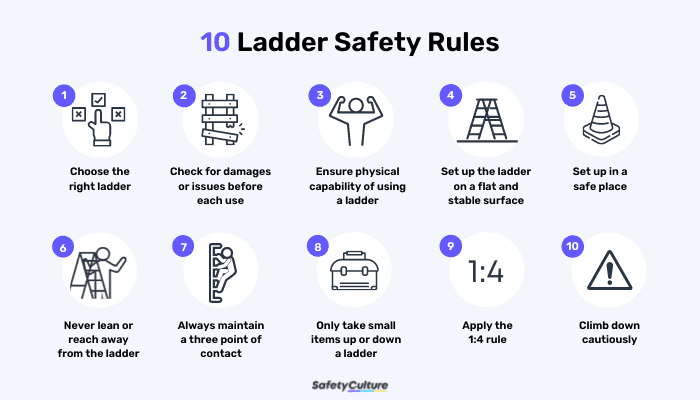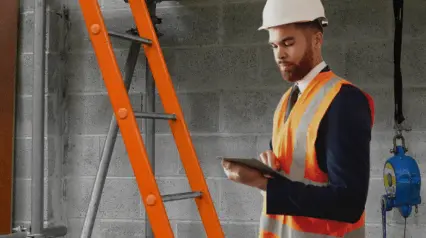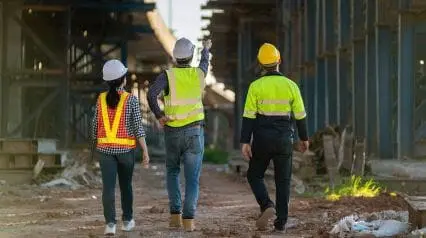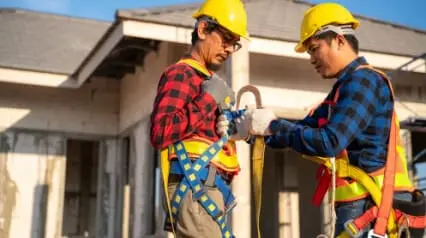Ladder Safety Rules
Ladders are great pieces of equipment. Nearly everyone has one at home or in the workplace. However, it may pose a threat to an individual’s safety if not used correctly.
According to Safe Work Australia, ladders should be used for simple access jobs for a short duration. Otherwise, an alternative can be used in place of a ladder, such as scaffolding or an elevated work platform. But if ladders are the only option, the following ladder safety tips and precautions should be taken:

1. Choose the right ladder
Different types of ladders have different uses. Each ladder type have a different load rating. When choosing the most suitable ladder for the job, it is important to consider the weight of the person climbing the ladder plus the weight of the tools, materials, and equipment. Below are five categories of ladders with their duty rating and weight capacity:
| Ladder Type | Duty Rating | Working Load (pounds) |
|---|---|---|
| IAA | Special Duty | 375 |
| IA | Extra Heavy Duty | 300 |
| I | Heavy Duty | 250 |
| II | Medium duty | 225 |
| III | Light Duty | 200 |
2. Check for damages or issues before each use
Over time a ladder may acquire issues that may lead to it being unreliable. A competent person should be assigned to visually inspect ladders for defects periodically. Below are some defects you should look out for:
- Structural damage, split/bent side rails, broken or loose rungs, steps, rails or braces. Other than that, loose screws, bolts, hinges, and other hardware parts
- Grease, dirt, or other contaminants that can result to slips or falls.
- Paint or stickers that might hide defects (Warning or safety labels not included).
If a ladder has been identified with defects, it’s best to have it repaired or replaced.
3. Ensure physical capability of using a ladder
A person using a ladder should be someone who has the capability of carrying out physical tasks. Physical capability is usually measured by one’s grip strength, walking speed, chair rising, and standing balance times. Employees should train workers to recognize ladder-related hazards to minimize accidents.
4. Set up the ladder on a flat and stable surface
Ladders should be placed on a firm and level surface for stability. The surface should be able to support the weight of the ladder and the person using it. In any case that the ground is soft, devices such as leg levelers, anti-slip gutter guards, wide boards, or stabilizers can be used.
5. Set up in a safe place
It is important to be mindful of the surroundings when setting up a ladder. The surrounding area should be uncluttered and free of obstructions. If a ladder needs to be set up in a driveway or passageway, barriers and signages, or a person assisting should be present.
6. Never lean or reach away from the ladder
Leaning and reaching away when in the ladder makes it unstable and puts the person in the ladder at risk of falling. To prevent falls, descend and then move the ladder.
7. Always maintain a three point of contact
When climbing or descending the ladder, the three points of contact should be observed for a secure handhold on the ladder. The three points of contact refers to two hands and one foot, or two feet and one hand.
8. Only take small items up or down a ladder
Always consider the load limits of the ladder in use. Carrying anything larger or heavier than what the ladder can take will make it unstable. The person in the ladder will be unable to maintain a three point of contact resulting to a fall and injury.
9. Apply the 1:4 rule
When using leaning ladders like an extension ladder, the position of the ladder should be angled at a ratio of 1:4. The base of the ladder being 1 meter away from the structure for every meter height of 4.
10. Climb down cautiously
Remain facing the ladder while maintaining the three points of contact when dissenting the ladder. Do it slowly; avoiding any sudden movements.
Consider working at height and fall protection factors too to promote safety at work, as well as regular ladder safety toolbox talks.
Raising the Safety Standard: Engage Your Team with Ladder Safety Training
Promoting a culture of workplace safety goes beyond simply discussing ladder safety during toolbox talks. It involves taking a holistic approach that fosters a strong sense of safety awareness among employees.
One key aspect is through specialized training on ladder safety. This empowers your workers with the knowledge and skills needed to effectively mitigate hazards related to ladders. Through proper training, they’ll learn how to avoid unstable footing, improper placement of ladders, overreaching, inadequate maintenance, and more.
Elevate your usual ladder safety toolbox talk to new heights with engaging and targeted training on ladder safety. The best part is that implementing Training no longer requires you to invest a lot of your time or resources. With user-friendly tools at your disposal, you can effortlessly convert your regular toolbox talk into interactive and concise ladder safety training modules that can be completed in just minutes.



